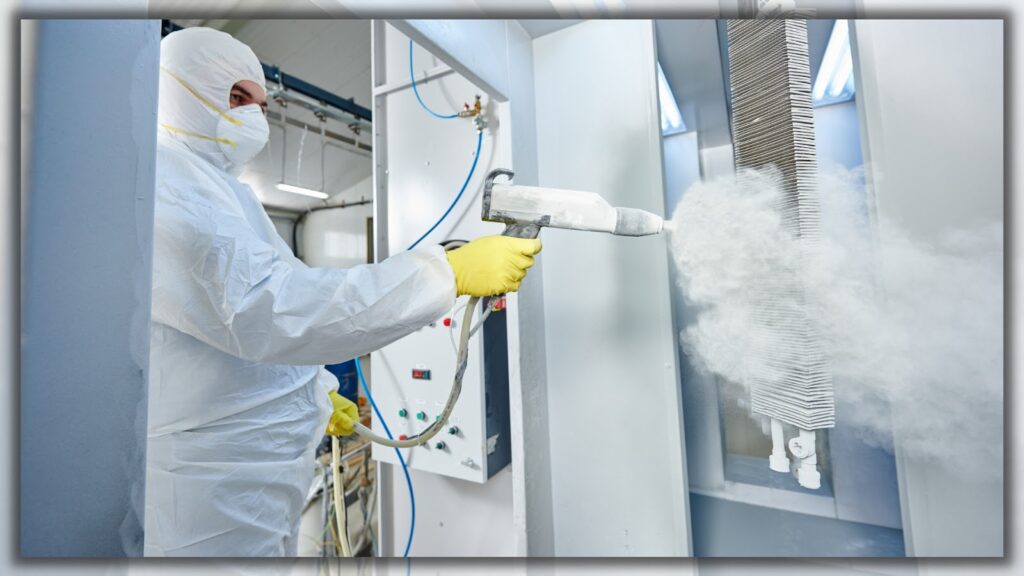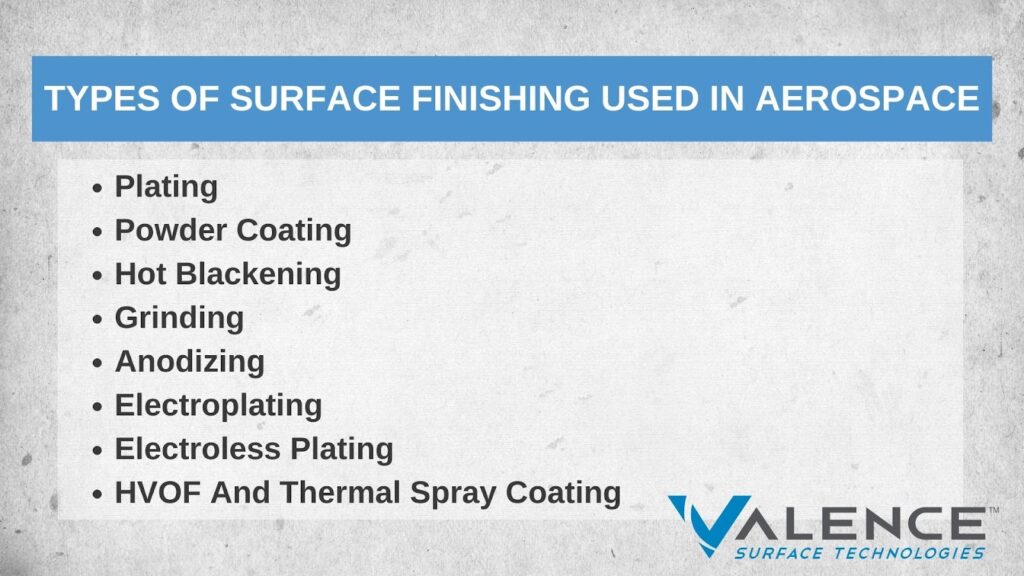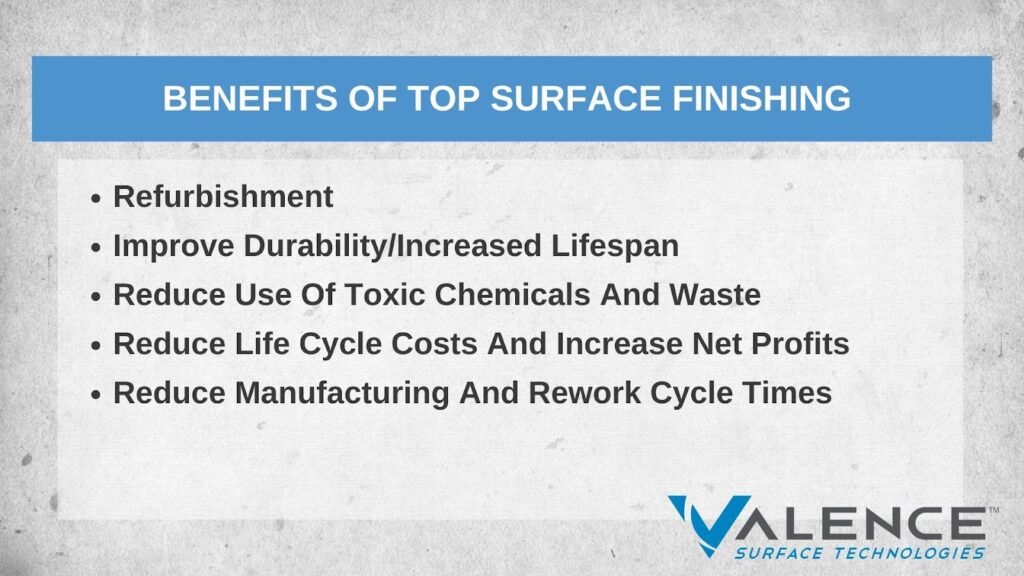The aerospace/aviation industry requires the highest standards of manufacturing and part quality. Failure of a flight-critical aero-engine or power transmission component is simply not an option.
Even the most experienced manufacturers find it difficult to get the best performance out of their metal parts, particularly if they are used in aerospace applications. After all, finishing is just as important as cutting and measuring the parts. There are many different finishing techniques that can be used, so picking the best one and executing it can be challenging.
In this article, we will discuss metal surface finish techniques, the top finishing techniques in the aerospace industry, their benefits, and their applications in the aerospace industry.
What Is Surface Finishing?
Surface finishing is the process of enhancing a material’s surface, typically a metal, by changing its surface characteristics like texture, color, and chemical makeup. This enhances the material’s overall functionality and appearance. Many industries, including aerospace, automotive, and medical, rely heavily on surface finishing.
In the aerospace industry, surface finishing is used to improve the durability and performance of components. Additionally, it can be used to make the component look better and improve electrical conductivity and friction.Surface finishing is a complex process that involves a variety of techniques. These techniques can include plating, powder coating, metal vibratory finishing, sand blasting, hot blackening, grinding, anodizing, electroplating, electroless plating, and HVOF and thermal spray coating. Each of these techniques has its own advantages and disadvantages, and it is important to choose the right technique for the job.
Types Of Surface Finishing Used In Aerospace
Surface finishing is an important process in the aerospace industry, as it is used to enhance the performance and lifespan of aerospace components. There are several types of surface finishing used in aerospace, including
Plating
Plating is a type of surface finishing used in the aerospace industry to protect and improve the appearance of components. It is a process that involves applying a thin layer of metal to the surface of a component. The metal layer can be made from a variety of metals, including gold, silver, nickel, copper, and zinc. Plating is used to enhance the appearance of a component, as well as to protect it from corrosion and wear.
In the aerospace industry, plating is a practical way to increase the durability and aesthetic appeal of components. Additionally, it can be applied to lessen friction and enhance electrical conductivity. To create a finish that is more durable, plating is frequently used in conjunction with other surface finishing methods like painting or powder coating.
Powder Coating
Powder coating is a type of surface finishing that is used in the aerospace industry. It is a dry finishing procedure that uses electrostatic spray deposition to apply colored powder to a substrate (ESD). After that, the powder is melted and fused to create a protective film. Aerospace component finishing through powder coating is aesthetically pleasing, reliable, and economical.
Excellent coverage, substrate adhesion, and corrosion and abrasion resistance are all features of powder coating. Additionally, it is resistant to chemicals, high temperatures, and ultraviolet light. Additionally, since it doesn’t use any solvents or dangerous chemicals, it is an environmentally friendly process.
Hot Blackening
In order to improve the aesthetic appeal of metal components and provide corrosion resistance, hot blackening is a surface finishing technique used in the aerospace industry. A heated blackening solution is applied to the component’s surface during hot blackening. Typically, this solution contains iron salts and other substances that interact with the component’s surface to form a protective layer. A thin coating of oil or wax is then applied to the protective layer to seal it and stop corrosion.
Grinding
In order to produce a smooth and even surface, the aerospace industry uses a type of surface finishing called grinding. It is frequently combined with other surface finishing techniques and is typically performed with a grinding wheel or abrasive belt. Burrs, surface imperfections, and an even, smooth surface finish can all be removed with grinding.
The versatile technique of grinding can be used to remove material from a variety of surfaces, including composites, steel, and aluminum. Additionally, a variety of shapes, such as flat surfaces, contoured surfaces, and curved surfaces, can be produced using it. A variety of finishes, such as matte, satin, and polished finishes, can be produced by grinding.
Anodizing
The aerospace industry uses anodizing, a surface finishing procedure, to protect and improve the appearance of metal components. It entails using an electrolytic procedure to coat the metal’s surface in a protective oxide layer. This coating can enhance the metal’s appearance while protecting it from corrosion, wear, and chemical attack.
The process of anodizing is adaptable and can be used to produce a range of finishes, such as matte, satin, or glossy ones. Additionally, a variety of colors, such as black, blue, green, red, and yellow, can be made using it.
Electroplating
Electroplating is a surface finishing process that applies a thin layer of metal to a substrate.\. Metal ions are drawn to the substrate by an electric current, which is typically used to apply this layer. The substrate is then joined by the metal ions, creating a thin layer of metal. The substrate may be covered with this layer to prevent corrosion, enhance its appearance, or boost electrical conductivity.
Aluminum, steel, and composite materials are just a few examples of the many substrates to which the metal coating can be applied. The method is a great choice for aerospace applications because it is reasonably easy and affordable.
Electroless Plating
In order to apply a uniform layer of metal to a variety of surfaces, the aerospace industry uses electroless plating as a surface finishing technique. This procedure is frequently used on composite materials because it can give the material a smooth finish and enhance its appearance. A chemical solution is applied to the surface of the material in the process, and the metal ions in the solution form a bond and create a layer of metal.
Without the use of an electrical current, the electroless plating procedure is a fairly easy one.
As a result, there is no chance of electrical shorts or any other potential problems, making it perfect for use on composite materials. The method is also reasonably priced, making it an economical choice for aerospace applications.
HVOF And Thermal Spray Coating
Two of the most widely used surface finishing methods in the aerospace industry are HVOF (High Velocity Oxygen Fuel) and Thermal Spray Coating. A stream of molten metal particles are propelled onto a substrate using a high-velocity jet of fuel and oxygen in the HVOF process, which results in a dense, hard, wear-resistant coating. A strong, wear-resistant coating is produced by the thermal spray coating process, which involves melting and spraying a metal or ceramic powder onto a substrate.
HVOF is frequently used in aerospace applications because, in comparison to conventional coating techniques, it provides better wear resistance and adhesion properties. In comparison to other techniques, it is also used to produce a surface finish that is smoother and more uniform, which reduces friction and enhances performance. On turbine blades, bearings, and other parts that are subject to high temperatures and wear, HVOF coating is frequently used.
Why Is Top Surface Finishing Important In Aerospace?
Because it helps to ensure that aircraft components are trustworthy and safe, surface finishing is a crucial component of the aerospace industry. Applying a protective coating to a component’s surface as part of the surface finishing process can increase its toughness, functionality, and aesthetic appeal. Additionally, it can aid in enhancing conductivity, lowering friction, and enhancing paint adhesion.
Surface finishing is essential for maintaining and updating aircraft parts. Components’ durability and lifespan can be extended, and their appearance can be restored and improved. In turn, this can lower the need for pricey maintenance and replacements, as well as lower the consumption of hazardous substances and waste.
Benefits Of Top Surface Finishing
Refurbishment
Refurbishment is the process of restoring a product to its original condition using surface finishing techniques. This is frequently done to increase an aerospace component’s lifespan or enhance its performance. Refurbishing a product is an affordable way to raise its quality without having to spend money on new components or materials
Sandblasting, metal vibratory finishing, and grinding are some surface finishing methods used in refurbishment. These methods can be used to clean contaminants, burrs, and other flaws from a product’s surface. This can lessen the chance of corrosion and wear while also enhancing the product’s overall appearance and functionality.
Improve Durability/Increased Lifespan
When it comes to aerospace applications, durability and lifespan are two of the most important factors to take into account. Aerospace industry materials and components can be made more durable and long-lasting by applying the best surface finishing techniques. By applying a protective coating or layer to the component’s or material’s surface, this is accomplished. Corrosion, normal wear and tear, and other types of damage are all reduced by the protective coating. Additionally, it aids in lowering the cost of component replacement and the necessity for frequent maintenance and repairs.
Reduce Use Of Toxic Chemicals And Waste
One of the main advantages of top surface finishing applications in the aerospace industry is the reduction of the use of hazardous chemicals and waste. Aerospace manufacturers can lessen their environmental impact while still achieving the desired results by using environmentally friendly processes like electroplating, electroless plating, HVOF, and thermal spray coating. These procedures not only work better, but they also release fewer dangerous substances into the environment.
Additionally, because they require fewer steps and resources, they can aid in reducing the amount of waste produced during production. Aerospace companies can produce high-quality products while also contributing to environmental protection by employing these procedures.
Reduce Life Cycle Costs And Increase Net Profits
For any aerospace company, lowering life cycle costs and raising net profits is a key objective. One of the most efficient ways to accomplish this is surface finishing. Applying a protective finish to the surface of components can help the product last longer by lowering the need for routine maintenance and repairs. This may result in significant labor, material, and energy cost savings as well as an increase in net profits.
Surface finishing can also help minimize the use of harmful chemicals and waste, increase product yield, and conserve resources. You can make sure you are getting the most out of your investment by selecting the appropriate surface finishing procedure for your aerospace products.
Reduce Manufacturing And Rework Cycle Times
One significant advantage of using top surface finishing applications in the aerospace sector is the reduction of manufacturing and rework cycle times. The amount of time it takes to complete a project can be decreased by aerospace manufacturers by using the appropriate methods and materials. Utilizing cutting-edge methods like electroplating and electroless plating can drastically reduce the time needed to finish a project.
Top Surface Finishing Applications In Aerospace
Surface finishing is an essential part of the aerospace industry. It is the process of improving the surface of a material in order to increase its durability, improve its appearance, and make it more resistant to wear and tear. Surface finishing can also be used to reduce friction, increase conductivity, improve paint adhesion, and protect against corrosion.
Friction Reduction
In the aerospace sector, surface finishing is crucial for reducing friction. It is used to lessen friction between two surfaces, which can enhance aircraft performance and decrease wear and tear. The most typical method of reducing friction is to lubricate the surface. This can be accomplished by using a liquid lubricant or by coating the surface, like with a dry film lubricant. Using both at once is an additional choice.
The specific application and the materials involved will determine the kind of lubricant that is used. For instance, a liquid lubricant is typically applied to composite surfaces, whereas a dry film lubricant is typically used on metal surfaces. The lubricant ought to be selected based on its capacity to lessen friction, compatibility with the materials, and environmental resistance.
Improved Durability
Improved durability is one of the primary benefits of top surface finishing in the aerospace industry. By applying a surface finishing process, the surface of a component can be protected from wear and tear, corrosion, and other environmental elements. This helps to extend the lifespan of the part, as well as reduce the need for costly repairs or replacements over time.
Surface finishing processes can also improve the durability of composite materials, which are increasingly being used in the aerospace industry. By applying a protective coating, the surface of the composite material can be shielded from environmental elements, such as UV radiation and extreme temperatures. This helps to increase the longevity of the material and reduce the need for costly repairs or replacements over time.
Improved Appearance
Aerospace component components can look better thanks to surface finishing. It can be applied to produce a visually appealing, uniform finish that is smooth. It can also be used to give something a distinctive appearance, like a brushed or textured finish. This can be used to give a component some style or to set it apart from the competition.
Improves Paint Adhesion
In the aerospace industry, paint adhesion is crucial. The adhesion of paint, which is crucial for aerospace components, can be improved with surface finishing. To ensure that the paint adheres properly and lasts for a long time, the component’s surface must be prepared and smoothed during the surface finishing process.
Our Surface Finishing Services
Valence is the only independent surface finishing company to offer a full suite of integrated finishing solutions, strategically located to support commercial, military and satellite manufacturing hubs across the United States.
Valence offers the following solutions, including:
Our process capabilities include:
Review our list of processes and Request a Quote today for the metal finishing services you need. Please feel free to Contact Us with any questions you might have.
Final Thoughts
In order to get the best out of any aviation metal finish, it is important to consult only reputable experts. Valence is the industry leader in quality for precision components in the aerospace, satellite, electronics, and medical device industries. With unique selective plating and precision masking techniques for critical plated components, we are the leading plating company for satellite and UAV applications, including a proprietary process for precision internal plating of waveguides.
We offer integrated honing and grinding capabilities to complement our cadmium and chrome plating. Check out the Valence process for more information on services and capabilities with your next project.
FAQs
What Safety Precautions Should I Take When Applying Surface Finishing?
When applying surface finishing, it is important to take safety precautions to ensure the safety of yourself and those around you. Wear protective clothing and eye protection when handling chemicals or working with machinery. Ensure that the area is well-ventilated and that all electrical equipment is properly grounded. Ensure that all materials and equipment are properly stored and disposed of according to local regulations.
What Is The Lifespan Of A Surface Finishing Process?
The lifespan of a surface finishing process will depend on the type of material being used and the environment in which it is being used. Generally, surface finishing processes can last for many years with proper maintenance and care.
Are There Any Special Considerations When Applying Surface Finishing To Composite Materials?
Yes, when applying surface finishing to composite materials, it is important to take into consideration the material’s reaction to the chemicals and treatments used in the process. Different types of composite materials may react differently to the same surface finishing process, so it is important to be aware of these differences and take the necessary precautions to ensure the best possible results.
What Is The Difference Between Surface Finishing And Surface Protection?
Surface finishing is the process of adding a protective layer to the surface of a material, while surface protection is the process of adding a protective layer to the surface of a material to protect it from wear and tear. Surface finishing is typically used to improve the appearance of a material, while surface protection is used to protect a material from damage.


